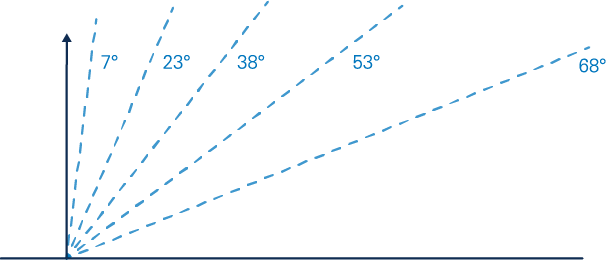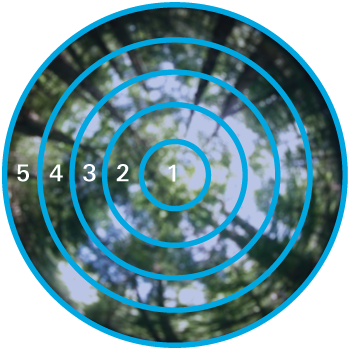基础测量理论
测量理论假设
使用 LAI-2200C 计算叶面积指数(LAI)需要对植被冠层作出一定的假设。这样可以在不破坏性地采样冠层的情况下进行准确测量。 LAI-2200C 基于以下四个假设进行测量:所有光线都被叶片吸收,叶片分布随机,叶片朝向随机,目标叶片元素(冠层)在传感器视野范围内距离传感器的距离足够远。
没有真正的冠层完全符合这些假设。叶片从不是随机分布的,而是沿着茎和枝干聚集,也不是“黑色的(所有光都被叶片吸收)”。许多物种表现出一定程度的日照性,这违反了方位随机性的假设。然而,许多冠层可以被视为随机分布,活体叶片在490纳米以下具有低透射和反射率。此外,可以通过散射校正纠正由于透射或反射引起的测量误差。
常见的测量误差包括叶片沿着茎秆方向聚集(透射率高于随机模型)。实际上,大多数违反假设的植被,可以通过适当的测量技术来克服,即使没有完全满足所有假设,模型计算结果仍然很好。

所有光线都被叶片吸收
即假设冠层下方的测量值不包括被叶片反射或透射的辐射。注意:在应用散射校正时,此假设将被移除,需在后续数据处理过程中应用叶片反射率和透射率。

叶片随机分布
这些冠层形态可能是:平行状冠层(例如:成行排列的农作物)、单一半球体(例如:孤立灌丛)、无限大箱状体(例如:草原)、带孔无限大箱体(例如:有林窗的落叶林)等。

叶片朝向随机
也就是说,枝叶的倾斜方向不重要,但叶片应该朝向所有方向。
叶片距离传感器镜头要足够远
需确保光学传感器镜头到最近的叶片等元素的距离至少应为叶片宽度的四倍。
计算叶面积指数
叶面积指数(LAI)是植物单侧叶片面积总和与地面面积的比值。 LAI‑2200C 从冠层上方和冠层下方进行测量,用于确定5个天顶角度下的冠层光截获。这些数据应用于一个成熟的植物冠层辐射传输模型,计算叶面积指数、平均倾斜角和冠层孔隙度。
LAI‑2200C 的光学传感器由一个鱼眼镜头和一个光学系统组成。鱼眼镜头可以“看到”半球形图像,光学系统将其聚焦到光电二极管光学探测器组上,该探测器组由五个同心环状探测器组成。


孔隙度
目前,孔隙度技术是目前间接获取冠层结构参数的一个强大又实用的工具。它不仅适用于连续的冠层,还适用于离散的包含叶片的封闭冠层,如行栽木或孤立木。
可以用孔隙度的测量估算冠层结构信息,包括叶片总量和倾斜角度。
某一冠层的孔隙度,是指冠层下方在某个方向上看到的未被叶片遮挡的视野部分。太阳光斑面积分数等于太阳方向上的孔隙度。
点击下载查看相关文献散射校正
LAI‑2000 和 LAI‑2200 的传统基本假设之一是,叶片吸收了传感器看到的蓝色波段(320-490纳米)中的所有辐射。这通常是一个良好的假设,适用于漫射光条件,如均质云层的阴天、无云的日出前或日落后的天气。然而,在阳光直射情况下,叶片的反射会导致孔隙度被大大高估,而叶面积指数将被低估。
参考文献
- Anderson, R. S. 1971. Radiation and crop structure. In: Plant Photosynthetic Production. Manual of Methods. (eds Z. Sestak, J. Catsky, and P. G. Jarvis). W. Junk, The Hague. pp 412-466.
- Anderson, R. S., D. R. Jackett, J. L. B. Jupp. 1984a. Linear functionals of the foliage angle distribution as tools to study the structure of plant canopies. Aust. J. Bot. 32: 147-156.
- Anderson, R. S., D. R. Jackett, J. L. B. Jupp, J. M. Norman. 1984b. Interpretation of and simple formulas for some key linear functionals of the foliage angle distribution. Agric. and For. Meteor. 36: 165-188.
- Bonhomme, R. and Chartier, P. 1972. The interpretation and automatic measurement of hemispherical photographs to obtain sunlit foliage area and gap frequency. Isr. J. Agric. Res. 22: 53-61.
- Chen, X. and Campbell, G.S. 1988. Microprocessor controlled instrument for measuring transmitted PAR and sunfleck fraction in plant canopies. Paper presented at American Society of Agronomy, Anaheim.
- Kobayashi, H., Ryu Y., Baldocchi, D.B.,Welles, J.M., Norman, J.M. (2013) On the correct estimation of gap fraction: How to remove scattered radiation in gap fraction measurements? Ag. and For. Meteorology, 174-175: 170-183.
- Lang, A. R. G., Y. Xiang, and J. M. Norman. 1985. Crop structure and the penetration of direct sunlight. Agric. and For. Meteor. 37: 229-243.
- Lang, A. R. G. and Y. Xiang. 1986. Estimation of leaf area index from transmission of direct sunlight in discontinuous canopies. Agric. and For. Meteor. 37: 229-243.
- Lang, A. R. G. 1986. Leaf area and average leaf angle from transmittance of direct sunlight. Aust. J. Bot. 34: 349-355.
- Lang, A. R. G. 1987. Simplified estimate of leaf area index from transmittance of the sun’s beam. Agric. and For. Meteor. 41: 179-186.
- Leblanc, S. G., Chen, J. M., Fernandes, R., Deering, D. W., Conley, A., 2005. Methodology comparison for canopy structure parameters extraction from digital hemispherical photography in boreal forests. Agric. and For. Meteor. 129: 187–207.
- Miller, J. B. 1963. An integral equation from phytology. J. Aust. Mat. Soc. 4: 397-402.
- Miller, J. B. 1967. A formula for average foliage density. Aust. J. Bot. 15: 141-144.
- Nilson, T., 1999. Inversion of gap frequency data in forest stands. Agric. and For. Meteor. 98–99: 437–448.
- Nilson, T., and A. Kuusk. 2004. Improved algorithm for estimating canopy indices from gap fraction data in forest canopies. Agric. and For. Meteor. 124: 157–169.
- Norman, J. M. and G. S. Campbell. 1989. Canopy structure. In: R. W. Pearcy, J. Ehlringer, H. A. Mooney, and P. W. Rundel (eds) Plant Physiological Ecology: Field Methods and Instrumentation. Chapman and Hall, London and New York, pp 301-325.
- Perry, S. G., A. B. Fraser, D. W. Thomson, and J. M. Norman. 1988. Indirect sensing of plant canopy structure with simple radiation measurements. Agric. and For. Meteor. 42: 255-278.
- Philip, J. R. 1965. The distribution of foliage density with foliage angle estimated from inclined point quadrat observations. Aust. J. Bot. 13: 357-366.
- Ross, J. 1981. The radiation regime and architecture of plant stands. W. Junk. The Hague, 391 pp.
- Ryu, Y., T. Nilson, H. Kobayashi, O. Sonnentag, B. E. Law, & D. D. Baldocchi. 2010. On the correct estimation of effective leaf area index: Does it reveal information on clumping effects? Agric. and For. Meteor. 150, 463-472.
- Van Gardingen, P. R., Jackson, G. E., Hernandez-Daumas, S., Russell, G., Sharp, L., 1999. Leaf area index estimates obtained for clumped canopies using hemispherical photography. Agric. and For. Meteor. 94 (3–4), 243–257.
- Walker, G. K., R. E. Blackshaw, and J. Dekker. 1988. Leaf area and competition for light between plant species using direct sunlight transmission. Weed Technology 2: 159-165
- Warren Wilson, J., and J. E. Reeve. 1959. Analysis of the spatial distribution of foliage by two-dimensional point quadrats. New Phytol. 58: 92-101.
- Welles, J. M. 1990. Some indirect methods of estimating canopy structure. In: J. Norman and N. Goel (eds) Instrumentation for studying vegetation canopies for remote sensing in optical and thermal infrared regions. Harwood Academic Publishers GmbH, London.
- Welles, J. M. and J. M. Norman. 1991. Instrument for indirect measurement of canopy architecture. Agron. J. 83: 818-825.
- Welles, J.M. and Cohen, S. 1996. Canopy structure measurement by gap fraction analysis using commercial instrumentation. Journal of Experimental Botany, 47: 1335-1342.
不同植被类型的测量
继续阅读






